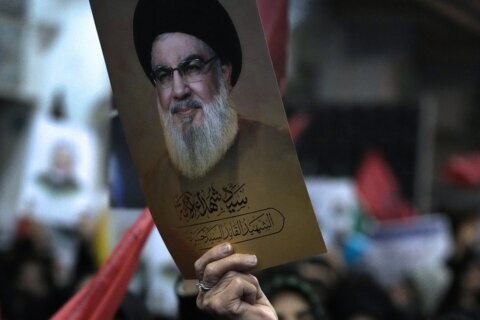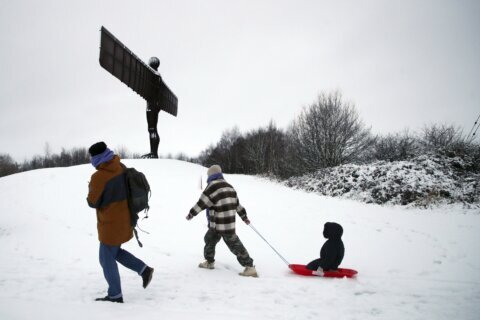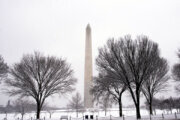BEIRUT (AP) — In 2006, after a bruising monthlong war between Israel and Lebanon’s Hezbollah militant group, the United Nations Security Council unanimously voted for a resolution to end the conflict and pave the way for lasting security along the border.
But while relative calm stood for nearly two decades, Resolution 1701’s terms were never fully enforced.
Now, figuring out how to finally enforce it is key to a U.S.-brokered deal that brought a ceasefire Wednesday.
In late September, after nearly a year of low-level clashes, the conflict between Israel and Hezbollah spiraled into all-out war and an Israeli ground invasion. As Israeli jets pound deep inside Lebanon and Hezbollah fires rockets deeper into northern Israel, U.N. and diplomatic officials again turned to the 2006 resolution in a bid to end the conflict.
Years of deeply divided politics and regionwide geopolitical hostilities have halted substantial progress on its implementation, yet the international community believes Resolution 1701 is still the brightest prospect for long-term stability between Israel and Lebanon.
Almost two decades after the last war between Israel and Hezbollah, the United States led shuttle diplomacy efforts between Lebanon and Israel to agree on a ceasefire proposal that renewed commitment to the resolution, this time with an implementation plan to try to reinvigorate the document.
What is UNSC Resolution 1701?
In 2000, Israel withdrew its forces from most of southern Lebanon along a U.N.-demarcated “Blue Line” that separated the two countries and the Israeli-annexed Golan Heights, which most of the world considers occupied Syrian territory. U.N. peacekeeping forces in Lebanon, known as UNIFIL, increased their presence along the line of withdrawal.
Resolution 1701 was supposed to complete Israel’s withdrawal from southern Lebanon and ensure Hezbollah would move north of the Litani River, keeping the area exclusively under the Lebanese military and U.N. peacekeepers.
Up to 15,000 U.N. peacekeepers would help to maintain calm, return displaced Lebanese and secure the area alongside the Lebanese military.
The goal was long-term security, with land borders eventually demarcated to resolve territorial disputes.
The resolution also reaffirmed previous ones that call for the disarmament of all armed groups in Lebanon — Hezbollah among them.
“It was made for a certain situation and context,” Elias Hanna, a retired Lebanese army general, told The Associated Press. “But as time goes on, the essence of the resolution begins to hollow.”
Has Resolution 1701 been implemented?
For years, Lebanon and Israel blamed each other for countless violations along the tense frontier. Israel said Hezbollah’s elite Radwan Force and growing arsenal remained, and accused the group of using a local environmental organization to spy on troops. Lebanon complained about Israeli military jets and naval ships entering Lebanese territory even when there was no active conflict.
“You had a role of the UNIFIL that slowly eroded like any other peacekeeping with time that has no clear mandate,” said Joseph Bahout, the director of the Issam Fares Institute for Public Policy at the American University of Beirut. “They don’t have permission to inspect the area without coordinating with the Lebanese army.”
UNIFIL for years has urged Israel to withdraw from some territory north of the frontier, but to no avail. In the ongoing war, the peacekeeping mission has accused Israel, as well as Hezbollah, of obstructing and harming its forces and infrastructure.
Hezbollah’s power, meanwhile, has grown, both in its arsenal and as a political influence in the Lebanese state.
The Iran-backed group was essential in keeping Syrian President Bashar Assad in power when armed opposition groups tried to topple him, and it supports Iran-backed groups in Iraq and Yemen. It has an estimated 150,000 rockets and missiles, including precision-guided missiles pointed at Israel, and has introduced drones into its arsenal.
Hanna says Hezbollah “is something never seen before as a non-state actor” with political and military influence.
How do mediators hope to implement 1701 almost two decades later?
Israel’s security Cabinet approved the ceasefire agreement late Tuesday, according to Prime Minister Benjamin Netanyahu’s office. The ceasefire began at 4 a.m. local time Wednesday.
Efforts led by the U.S. and France for the ceasefire between Israel and Hezbollah underscored that they still view the resolution as key. For almost a year, Washington has promoted various versions of a deal that would gradually lead to its full implementation.
International mediators hope that by boosting financial support for the Lebanese army — which was not a party in the Israel-Hezbollah war — Lebanon can deploy some 6,000 additional troops south of the Litani River to help enforce the resolution. Under the deal, an international monitoring committee headed by the United States would oversee implementation to ensure that Hezbollah and Israel’s withdrawals take place.
It is not entirely clear how the committee would work or how potential violations would be reported and dealt with.
The circumstances now are far more complicated than in 2006. Some are still skeptical of the resolution’s viability given that the political realities and balance of power both regionally and within Lebanon have dramatically changed since then.
“You’re tying 1701 with a hundred things,” Bahout said. “A resolution is the reflection of a balance of power and political context.”
Now with the ceasefire in place, the hope is that Israel and Lebanon can begin negotiations to demarcate their land border and settle disputes over several points along the Blue Line for long-term security after decades of conflict and tension.
___
Follow AP’s coverage of Mideast wars at https://apnews.com/hub/mideast-wars
Copyright © 2025 The Associated Press. All rights reserved. This material may not be published, broadcast, written or redistributed.






